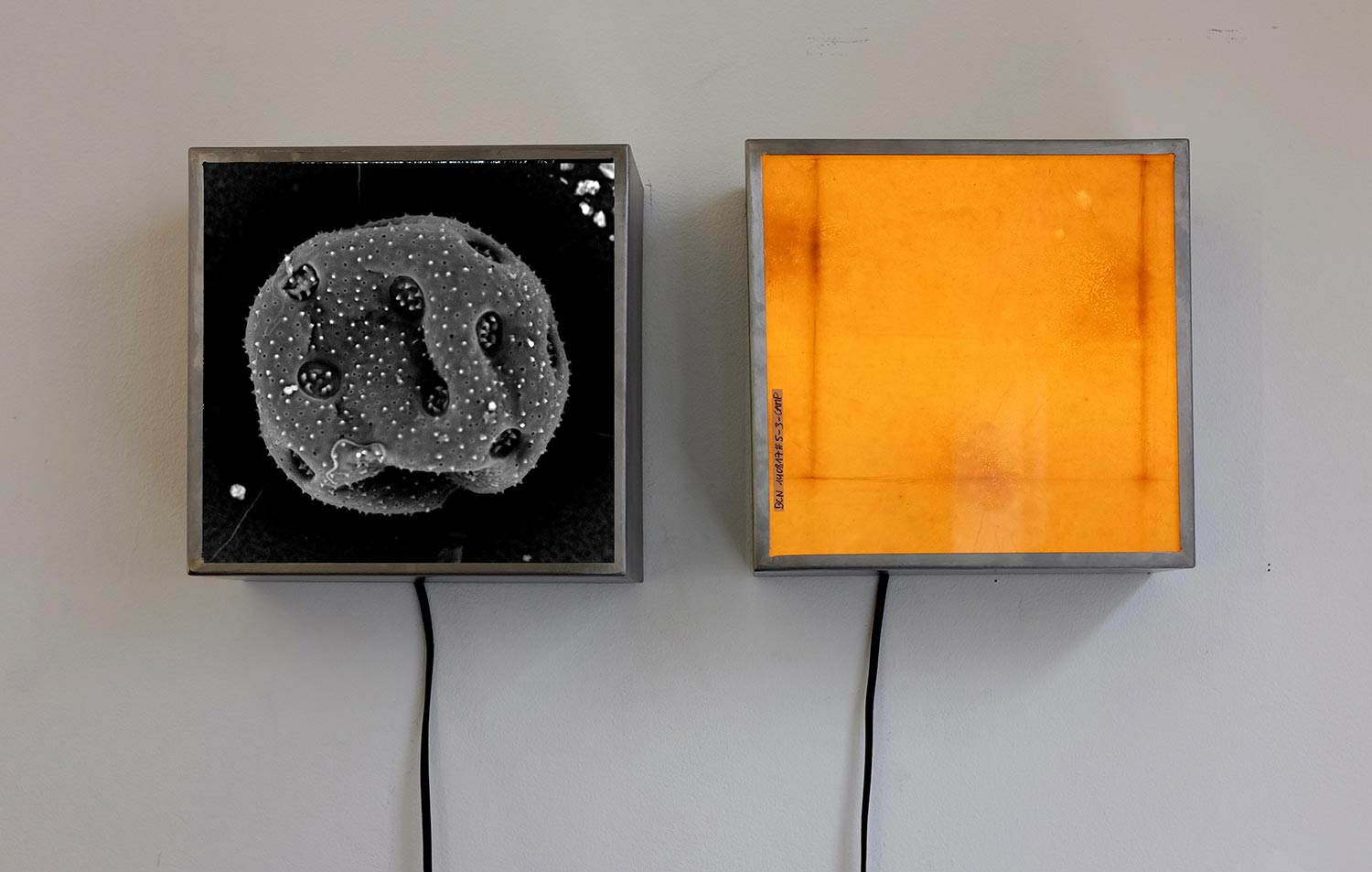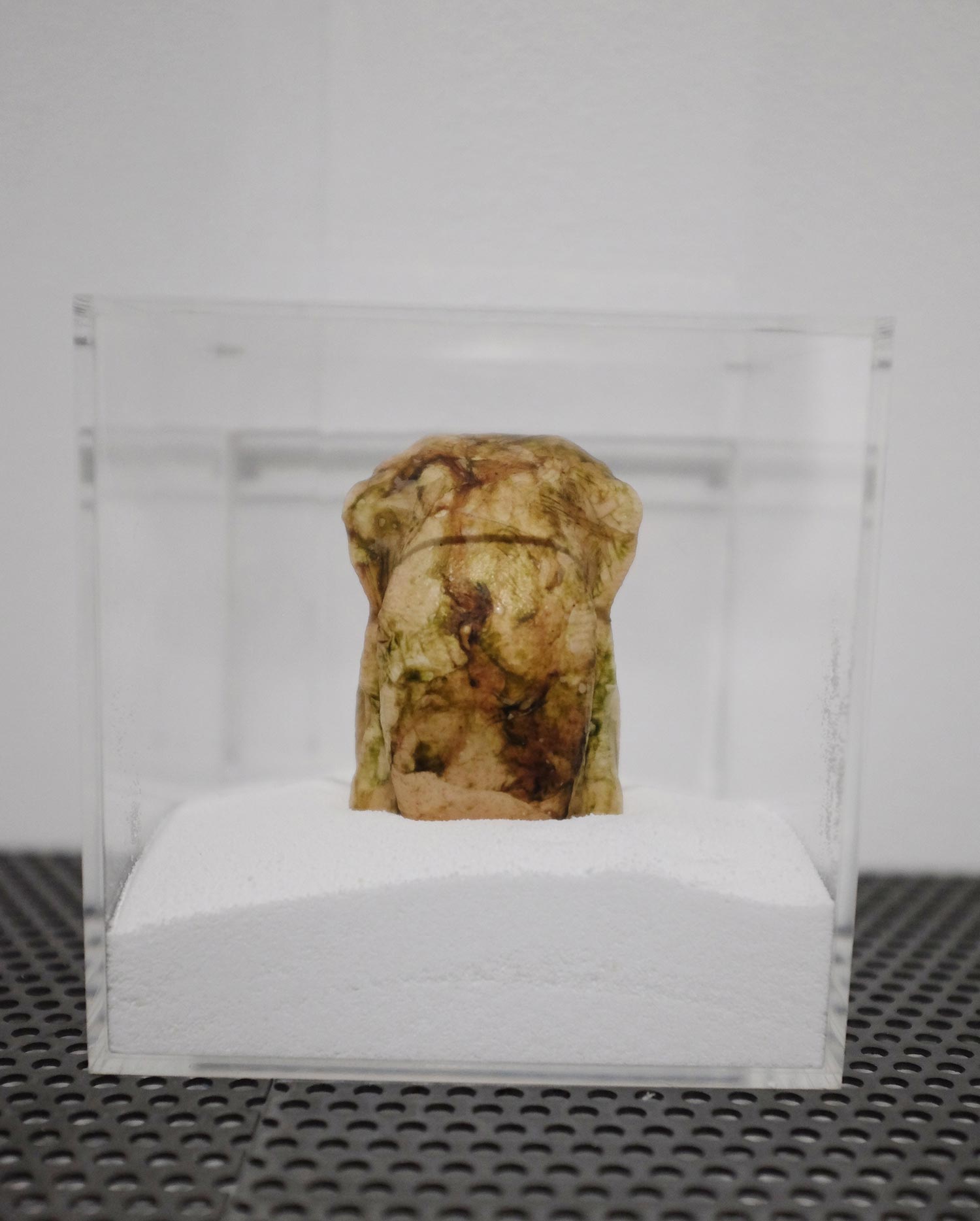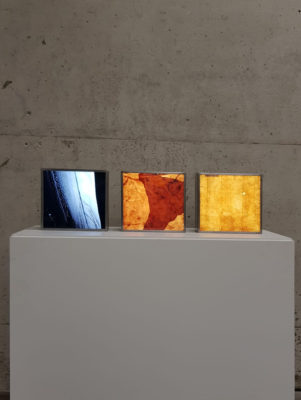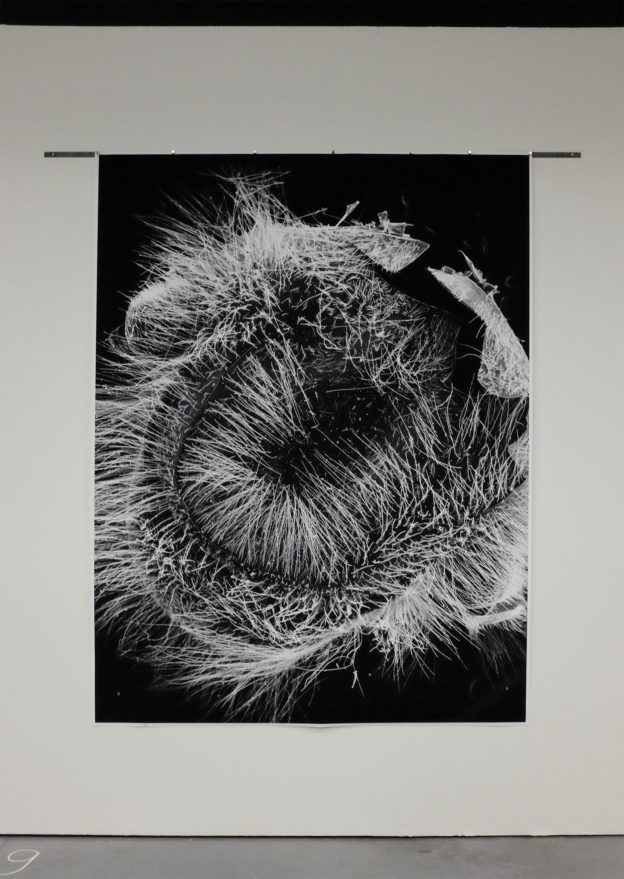Caput (head): Since Darwin, it is clear that flowers and bees engage in an evolutionary race. The honeybee is a complex insect with numerous sensorial features which are matching perfectly with the demands of sensual plants. The black-and-white photographs reveal the elaborate design of some dissected parts of flowers and honeybees. All samples are collected in the Urban Bee Lab, Maes’ apiary and rooftop garden laboratory in the centre of Brussels. The artist made the images with a Scanning Electron Microscope (SEM) in the laboratory of chemical engineering at the Vrije Universiteit Brussels (VUB), with the help of Dr. Alexander Lutz.
Intelligent Guerrilla Beehive research: The Intelligent Guerilla Beehive is an artwork and a prototype for a speculative research project. It is a mobile shelter for swarming honeybees that combines in a radical way smart materials, biomimetic forms and biotechnology. The beehive is equipped with sensors to monitor the health status of the environment and that of the bees. Colonies of color-changing bacteria, living on the skin of the hive, act as biosensors. These small sculptures, belonging to a series of 12, were developed during the research of the IntelligentGuerrilla Beehive project.

‘Caput’ (head)
Scanning Electron Micrography of a Honeybee’s Head (2018)
B/W print on Hahnemühle paper 300gr 165cm x 215cm
Disrupted Sensations: A series of lightboxes containing smart materials and Scanning Electron Micrographs (SEM) of Honeybee parts and pollen grains. The artist studies the processes by which nature operates and how she can use these processes to create her own intelligent materials. She experiments with a range of organic components; for these lightboxes she worked with fabrics that are spun by Acetobacter xylinum bacteria from nano cellulose fibers. Additives to the growth medium of the bacteria can change specific properties of the material as color or durability. AnneMarie Maes experimented for the color of the microbial skins with natural additives as curcuma, beetroot and cochineal dyes.

‘Disrupted Sensations’
Lightboxes (2017) 26cm x 26cm x 14cm
Techniques & Materials: microbial cellulose, vegetal dyes, SEM (Scanning Electron Photography of honeybee parts). Brushed metal lightbox, plexiglas, duratrans prints, Led-lights, transfo.

‘Little Spicy Planet and Orange Shade’
Lightboxes (2017) 26cm x 26cm x 14cm
Techniques & Materials: microbial cellulose, vegetal dyes, SEM (Scanning Electron Photography of Pollen grain). Brushed metal lightbox, plexiglas, duratrans prints, Led-lights, transfo.
Intelligent Guerrilla Beehive research: The Intelligent Guerilla Beehive is an artwork and a prototype for a speculative research project. It is a mobile shelter for swarming honeybees that combines in a radical way smart materials, biomimetic forms and biotechnology. The beehive is equipped with sensors to monitor the health status of the environment and that of the bees. Colonies of color-changing bacteria, living on the skin of the hive, act as biosensors. These small sculptures, belonging to a series of 12, were developed during the research of the IntelligentGuerrilla Beehive project.


‘Intelligent Guerrilla Beehive research’
Objects and 3D prints (2017-2019), each 13cm x 13cm x 13cm
Belonging to a series of 12 small sculptures, developed during the research of the IntelligentGuerrilla Beehive project.
The objects are presented in clear plexi boxes, each 13cm x 13cm x 13cm, on white sand.
Materials: wax, latex, epoxy, bacteria, organic dyes, electronics, 3D printed PLA, seeds, aquarium sand.
AnneMarie Maes is an artist who has been studying the close interactions and co-evolutions within urban ecosystems. Her research practice combines art and science, with a keen interest in DIY technologies and biotechnology. She works with a range of biological, digital and traditional media, including live organisms. Her artistic research is materialised in techno-organic objects that are inspired by factual/fictional stories; in artefacts that are a combination of digital fabrication and craftsmanship; in installations that reflect both the problem and the (possible) solution, in multispecies collaborations, in polymorphic forms and models created by eco-data.
On the rooftop of her studio in Brussels she has created an open- air lab and experimental garden where she studies the processes that nature employs to create form. Her research provides an ongoing source of inspiration for her artworks.
Bee Agency as well as the Laboratory for Form and Matter -in which she experiments with bacteria and living textiles – provide a framework that has inspired a wide range of installations, sculptures, photography works, objects and books – all at the intersection of art, science and technology. The choice of materials is a primary aspect of her artworks. The physical and aesthetic features of the materials she works with determine the forms of the individual sculptures, objects or textiles. Her artworks are appealing to touch and smell, but as well they attract the spectator in an aesthetic and visual way.
AnneMarie Maes has exhibited in art centres and at festivals around the world. In 2017, she received an Honorary Mention in the Hybrid Art category at Ars Electronica for the Intelligent Guerrilla Beehive project.
www.annemariemaes.net


Presentation at Ars Electronica 2019, Gluon Gallery
https://ars.electronica.art/outofthebox/en/guerrilla-beehive/
